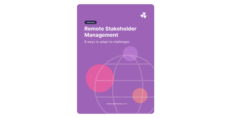How To Succeed at Remote Stakeholder Engagement For Your Project

Need to engage with remote stakeholders for your project? Remote stakeholder engagement has emerged as an important practice over the last decade or so — but particularly following the COVID-19 pandemic and rise in work-from-anywhere culture.
With a growing number of distributed teams, customers, and colleagues, it’s increasingly common for project stakeholders to interact and engage online and never meet in-person. Especially with many companies now operating in a global economy, with team members, customers, partners, and stakeholders all over the world.
So, does stakeholder engagement even matter in this situation? In short — yes. No matter where your stakeholders are, it’s important that you engage with them. Stakeholder engagement is important for:
- Getting project buy-in
- Get stakeholders to collaborate together
- Gaining valuable input in the form of knowledge, feedback, and skills
- Encouraging interest in the project — and helping people understand and accept change
- Reducing the risk of failure due to disengagement, lack of involvement, delays, limited understanding, or low support
- Anticipating risks and potential conflicts
- Getting people’s attention — especially when they’re busy and have competing priorities and other projects they’re involved in
- Getting stakeholders to commit to the project and follow through on their commitments
So, how do you actually do it?
How to Successfully Engage Remote Stakeholders
Although the principles of stakeholder engagement remain the same, engaging with remote stakeholders does require some specific considerations and tactics. Here are some tips to help you successfully engage with people or groups — even from the other side of the world.
1. Set Objectives
It’s always a good idea to start with the end goal in mind and set some objectives for your stakeholder engagement. What do you hope to achieve from engaging with your remote stakeholders? How will you know whether you’ve been successful? We’ve already discussed the ‘why’ of remote stakeholder engagement above, but you can take this one step further and set some specific goals, like:
- Make sure that every remote stakeholder knows about the project
- Gain at least 60% support from remote stakeholders
- Get 80% of stakeholders to participate in the project every week
These goals should be tied to the overall purpose of the project and your organization’s strategic objectives. If you’ve got a written stakeholder engagement plan (and you should), make a note of your goals and objectives.
2. Analyze Your Remote Stakeholders

Don’t assume your remote stakeholders have the same interests, issues, and needs as the stakeholders you deal with face-to-face. A lot of the time, their needs and experiences will be quite different — and these will impact your approach.
You’ll need to conduct a thorough stakeholder analysis to better understand these stakeholders. Note down demographics, interests, issues, preferences, and more. Identify stakeholder expectations so that you can find ways to meet them — or anticipate potential conflicts.
3. Map Your Stakeholders
Stakeholder mapping can help you visualize your stakeholder attributes. For instance, you might map them based on impact, influence, or interest. Or you could geographically map your remote stakeholders to understand where they’re located. Or even conduct stakeholder relationship mapping.
This process can help you segment your stakeholders into logical groups to engage with — and prioritize the stakeholders you need to engage with first (or more frequently).
4. Build a Culture of Trust
Successful remote engagement requires you to build a culture that promotes trust, engagement, and empowerment. So, how do you do that?
Trust comes from:
- Transparency, especially because it can support greater accountability
- Defining an overarching purpose that provides clarity and assurance regarding any future plans
- Committing to a plan and taking consistent action towards stated goals
- Acting with integrity — in other words, doing what you say you’ll do
- Meeting stakeholder needs and expectations (and then going above and beyond)
- Providing stakeholders with benefits and/or protection from harm
5. Be Clear
Clear communication is always important in stakeholder engagement — but even more so when you’re engaging with remote stakeholders. Remember that your stakeholders will probably be distracted when they read your messages, and you won’t have non-verbal cues like body language to let you know if someone has heard or understood. So, stick to the point, make instructions obvious, and check for potential causes of misunderstanding before you hit send.
6. Share Updates

Provide regular updates to stakeholders so that they know what’s happening in the project. In remote project management, you’ve often waiting for others to provide input, take action, or make a decision in order to continue moving forward.
Part of your stakeholder communication may involve identifying actions or people that are blocking your progress. As a project manager, you will likely have more visibility over this than other stakeholders. It’s up to you to ensure everyone is aware and in alignment so you can keep the project on track.
7. Be Relevant
Ensure that the information and reports you send through are relevant to stakeholders. The more relevant your communication, the more likely your stakeholders will stay engaged in the project and continue to open emails, read documents, and participate.
Consider using your stakeholder maps and segmentation to tailor your communication based on stakeholder interests, issues, and other characteristics.
8. Encourage Participation
When someone’s not in the room with you, it can be much easier for them to become disengaged in a project. With remote stakeholder engagement, you need to be proactive about encouraging participation. Use your stakeholder software to track every interaction, assess your stakeholder relationships, and see who is and isn’t engaging regularly (so that you can follow up as needed).
And when someone is engaged, acknowledge their contributions. Thank people for their work and contribution — both privately and publicly. And provide reports on your stakeholder engagement activities, outcomes, and impacts.
This not only helps to encourage your stakeholders to engage more in future, but demonstrates that their participation is genuinely contributing to the project.
9. Create Feedback Channels
Depending on your project or organization, there are a number of ways you can gather feedback from remote stakeholders. For instance, you might create a dedicated Slack or Teams channel, set up a survey, create a feedback email address, or provide a meeting link to schedule a call on Zoom.
And of course, it’s important to respond to any feedback that comes through. Listen to your stakeholders, demonstrate that you’ve heard them, and follow up with action if required.
10. Consider Differences and Barriers

It’s always a good idea to consider barriers to your stakeholder engagement, but certain barriers are more common with remote stakeholders. For instance, in a global organization or market, you’re more likely to come across cultural barriers, language barriers, and different time zones. Other considerations include disabilities and accessibility issues that may prevent someone from engaging.
A few ways to overcome these barriers might include allowing people to switch their video on/off, implementing closed captions, providing communication in a range of formats, and switching up the time of regular meetings or events. Many platforms also offer in-app translation tools to help overcome language barriers.
11. Accommodate Communication Preferences
Understand that each stakeholder will have different communication preferences and platforms they prefer to engage on. Some will prefer synchronous communication, while others will prefer asynchronous. Some will want to chat on Slack, others prefer email, and others will want to jump on a video call. Some are more likely to watch a recorded video, and others will prefer to read a detailed article. You’ll probably find that a lot of your remote stakeholders will engage across a mix of communication channels, depending on the situation.
12. Use the Right Tools
You’ll find a wealth of tools available for remote stakeholder engagement, but it’s important to choose the right ones. Try to avoid gathering information in too many places, while balancing the need for engaging across multiple channels.
For many organizations, it’s worth investing in stakeholder engagement software to effectively track and manage remote stakeholders. Software like Simply Stakeholders can help by keeping a record of interactions across a range of platforms, including email, surveys, phone calls, and more. And it can allow you to analyze your stakeholder data, organize your contact lists, stay on top of tasks, and generate reports.
Contact our team if you’d like to learn more about what Simply Stakeholders can do for you.
Get Our eBook on Remote Stakeholder Management
Want to learn more about engaging with remote stakeholders? Check out our eBook on Remote Stakeholder Management. Inside the book we share best practices, remote work policies, new methods, checklists, and more!



































